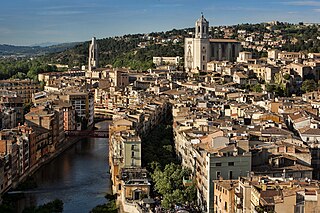
Girona is the capital city of the province of Girona in the autonomous community of Catalonia, Spain, at the confluence of the Ter, Onyar, Galligants, and Güell rivers. The city had an official population of 103,369 in 2020 but, the population of the Girona–Salt urban area is estimated to be about 156,400 (2020). Girona is also capital of the comarca of the Gironès and the vegueria of Girona. Since much of the old quarter of this ancient city has been preserved, Girona is a popular destination for tourists. The city is located 99 km (62 mi) northeast of Barcelona.

Figueres is the capital city of Alt Empordà county, in the Girona region, Catalonia, Spain.
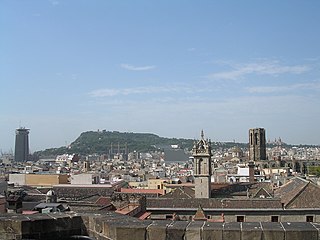
Montjuïc is a hill in Barcelona, Catalonia, Spain.

Palau de la Música Catalana is a concert hall in Barcelona, Catalonia, Spain. Designed in the Catalan modernista style by the architect Lluís Domènech i Montaner, it was built between 1905 and 1908 for Orfeó Català, a choral society founded in 1891 that was a leading force in the Catalan cultural movement that came to be known as the Renaixença. It was inaugurated on 9 February 1908.

Besalú is a town in the comarca of Garrotxa, in Girona, Catalonia, Spain.
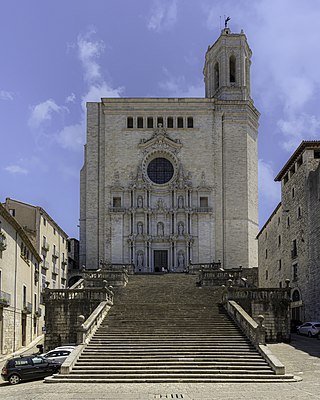
The Cathedral of Saint Mary,, is a Roman Catholic cathedral located in Girona, Catalonia, Spain. It is the seat of the Roman Catholic Diocese of Girona.

One of the first streams of Romanesque architecture in Europe from the 10th century and the beginning of 11th century is called First Romanesque or Lombard Romanesque. It took place in the region of Lombardy and spread into Catalonia and into the south of France. Its principal decoration for the exterior, bands of ornamental blind arches are called Lombard bands. It was characterized by thick walls and lack of sculpture in facades, and with interiors profusely painted with frescoes.

La Vall de Boí is a municipality and narrow, steep-sided valley in Catalonia. It lies in the Alta Ribagorça county in the Alt Pirineu region, on the edges of the Pyrenees. In 2022, it had a population of 1,090.

The third siege of Girona occurred in northern Catalonia, Spain from 6 May to 12 December 1809, during the Napoleonic Wars. A significant event of the Peninsular War, France's Grande Armée lay siege to the town of Girona for seven months. Girona was strategically important because it controlled the main road between France and Spain.

Sant Pere de Roda is a former Benedictine monastery in the comarca of Alt Empordà, in the North East of Catalonia, Spain.

Palau-saverdera (Old Catalan for 'Palace-[Castle of] the Verdera'; is a municipality in the comarca of Alt Empordà, Girona, Catalonia, Spain.

Requesens Castle is situated on a hill overlooking the southern valleys of Mount Neulós, approximately 7 km east of the Requesens neighbourhood. For centuries, it has controlled the passage into Spain and corresponds to the ancient village of Requesens, a settlement in La Junquera.

Sant Pere de Galligants is Benedictine abbey in Girona, Catalonia. Since 1857, it is home to the Archaeology Museum of Catalonia venue in the city. The name translates to English as "Saint Peter of Galligants", where Galligants refers to the River Galligants that runs past the abby.
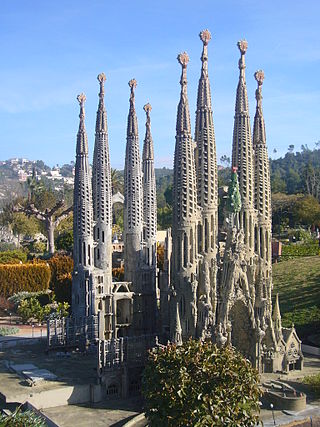
Catalunya en Miniatura is a miniature park inaugurated in 1983 in Torrelles de Llobregat, 17 km (11 mi) from Barcelona. The park is 60,000 m2 (650,000 sq ft), 35,000 m2 (380,000 sq ft) of them devoted to the scale models, it is one of the largest miniature parks in the world, and the largest of the 14 miniature building exhibitions present in Europe. It displays 147 models of palaces, churches, bridges and other buildings from Catalonia and Mallorca and it includes all the major works by the renowned architect Antoni Gaudí.
Catalan Gothic is an artistic style, with particular characteristics in the field of architecture. It occurred in the Principality of Catalonia within the Crown of Aragon between the 13th and 15th centuries, which places it at the end of the European Gothic period and at the beginning of the Renaissance. The term Catalan Gothic is confined to Barcelona and its area of influence, which has its own characteristics.

Hostalric is a village in the province of Girona and autonomous community of Catalonia, Spain. The municipality covers an area of 3.39 square kilometres (1.31 sq mi) and the population in 2014 was 4,010.

The Mural paintings of the Conquest of Majorca is a group of Gothic paintings, created on 1285-1290, conserved at the National Art Museum of Catalonia, in Barcelona, Spain.

Sant Pere de Camprodon is a Benedictine monastery in Camprodon, Ripollès, Catalonia, Spain. It was declared a Bien de Interés Cultural landmark in 1931.
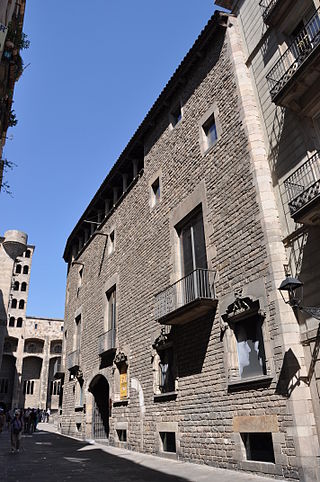
The Museum of the History of Barcelona is a history museum that conserves, researches, communicates and exhibits the historical heritage of the city of Barcelona, from its origins in Roman times until the present day. The museum's headquarters are located on Plaça del Rei, in the Barcelona Gothic Quarter. It also manages several historic sites all around the city, most of them archaeological sites displaying remains of the ancient Roman city, called Barcino in Latin. Some others date to medieval times, including the Jewish quarter and the medieval royal palace called the Palau Reial Major. The rest are contemporary, among them old industrial buildings and sites related to Antoni Gaudí and the Spanish Civil War.

Montjuïc is a hill of the ancient Catalan city of Girona, Spain. Montjuïc is located just to the north of the old quarter of the city, near the confluence of the Onyar, Galligants, and Ter rivers. Montjuïc is also the name of the present-day neighborhood and district of Girona on the hill. The name "Montjuïc" translates from medieval Catalan as "mountain of the Jews". The hill has an altitude of 219 m.



















